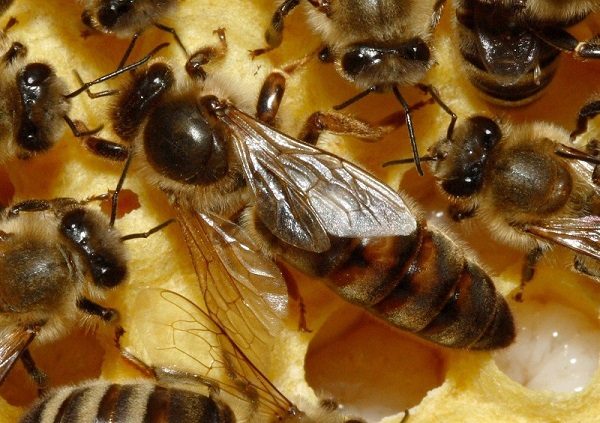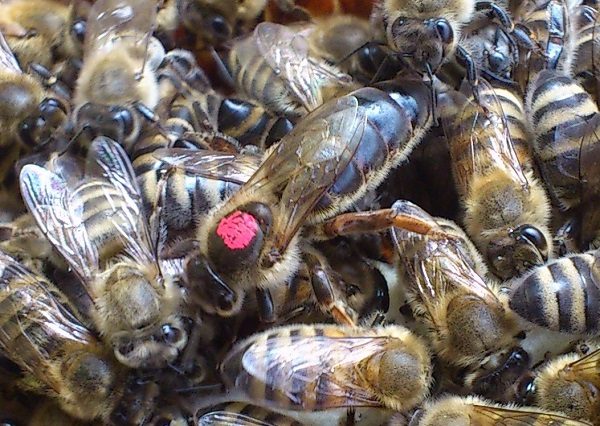The main function of the queen bee is egg laying. In the family there is only one fetal individual. The bees take care of their parent and protect them. She has her own retinue, which provides her with nutrition (royal jelly).
Table of contents
Beekeeping for beginners: what does a queen bee look like?
The queen bee, or as the Queen Queen beekeepers call it, is the parent of all the bees living in the hive. In nature, its life span can reach up to 8 years., but in beekeeping, the uterus usually changes to a young one after 2 years. This is due to the fact that the active sowing of eggs occurs in the first two years, then reproduction decreases. A beekeeper can change it before, if it does not give good results.
Now let's talk about what the queen bee looks like. It can easily be distinguished from working bees in shape and size. It has an elongated body, reaching sizes of 2-2.5 cm. Its abdomen, unlike the rest of the bees, protrudes beyond the wings. At the end there is a sting, but it will be used to protect against other bee maids.
It has a smaller eye size. Weight - 0.025 grams, and barren - 0.020 grams. Weight and size depend on the age of the bee and breed. Uterus are fetal and barren. The first ones make the sowing by working bees, the second sow the drones.

How long does it take to remove a queen bee from scratch in a natural way?
Let's look at how and how many days the queen bee hatch? Those beekeepers who are seriously engaged in apiary, This knowledge is necessary for the following reasons:
- To change the old individuals to the young.
- For tribal work.
- To prevent the swarming of bees.
- To control sowing.
- It will help to identify the tinder.
The process of hatching the bee-woman begins with seeding the egg. The uterus is removed from the ovum, which later sows working bees. Truths are derived from poor seeding.
In a bowl built on honey comb, the uterus sows eggs. From it develops a larva that is cared for and protected by bees. The larva of the future uterus is fed with royal jelly and continues to draw out the queen from the pan. On the 7th day they seal it.
Before they are sealed, they fill it with feed for the larvae. It is royal jelly. Those beekeepers who collect it for sale, just this time is the most convenient for collecting.
After how many days the bee's uterus is removed and leaves the queen cell? Before leaving the mother liquor, the larva, feeding on milk, grows and turns into a pupa. From the pupa to the uterus. For some time, she still matures in the mother liquor. On the 16th day there is an exit from the queen cell., by his vygryzaniya.
In the first time after leaving the queen cell, the young uterus is gaining strength and eliminates the other queen cells. At the same time, they are divided into fetuses and trushes. Those individuals that within 7 days fly around and mate with the drones become fruitful. The whole family is involved in this process. If this happens, then after 3 days in the hive should appear sowing working bees.

Fetal uterus can live 5 years, but for the production of honey for so long it is inappropriate to keep it. After 2 years, it should be changed to young, because after this time the sowing is reduced. Autumn sowing ends early, and spring begins later. If the uterus does not fly around, then a drone sowing will appear in the hive. Such a family is doomed. Trunk should be removed and addicted to the fetal individual.
Cycle, stages and timing of the development of larvae in the mother liquor by day
Schedule hatching bees.
| On the 7th day | Mother liquor is sealed |
| On the 16th day | Output barren individuals |
| After 3-5 days in the hive | Circled |
| In 7 days | Mating flight |
| After 14 days | The ability to determine the quality of the uterus |
Without mating with drones, it is impossible to obtain a fetal uterus. But the number of drones in the hive must be constantly monitored. How does the drone develop?
The drone is formed in the same way as the worker bee, but has a longer development cycle. If you look at the honeycomb, the cells with drones in the honeycomb are larger. They have a convex, loose cap. From egg to adult individual passes 24 days. To mate the drone will be ready for 33 days. Therefore, it is important to look at the calendar and not miss the time.
How is the uterus without larvae displayed?
A simple method used by beekeepers to get a young womb without buying. Popular on private apiaries and available for beginners. To succeed in hatching a uterus, choose a strong family.. If a queen is needed more, then several families are chosen.
An insulator is installed in the central part of the body, more precisely in the interframe space, where the egg-laying will take place. If there is no isolator, they can be replaced with honeycombs. At the stage when the larvae appear in the honeycomb, they are deposited in the prepared layer.
Further actions of the beekeeper
- After 6 hours, honeycombs with laid eggs are taken. Removed from the hive.
- Heated by a knife, cut a strip with laid eggs.
- On one side, cut to half the height. Of the three cells left alone.
- On the remaining cells with larvae, stick gently expand the holes (artificially make bowls). Here the queen cells will line up.
- The strip prepared in advance is attached to an empty honeycomb frame.
- A hole is made with a height of no more than 5 cm (parallel to the bar above).
- The strip is glued with melted wax or wooden pins. It is taken into account how many queens are required and as many holes are made.

Beekeeping
The queen is raised where the larvae are selected. The frame is placed on the site of the one that was removed before. There will be a cluster of working bees, which constantly monitor the order, for the timely delivery of royal jelly and the alignment of queen cells.
Thus the family turns into educators. Before the appearance of the uterus, the mother liquor is cut and placed in the nucleus or cells. Thus, an individual is grown without transfer of the larvae.
You may also be interested in the following articles on beekeeping:
Basic Inference Rules
Uterus is raised simultaneously with brood of drones (thus matured drones appear).
- Fertile individual appears with good honey collection.
- The uterus grown from large larvae is better than from small ones.
- For hatching 12 hours are used.
Two-legged maintenance of the bee family
The two-month maintenance of bee colonies allows to increase the hives to the main honey collection and Thus, you can increase the collection of honey by 50%. It is advisable to keep this method in central Russia and in its northern regions, since the period of honey collection in these regions is short and most often ends in July.
The advantages of dvuhtomechnogo content of bees in multihull hives:
- in winter, feed consumption decreases (due to mutual heating);
- sowing increases;
- increases the activity of the bee;
- honey harvest increases.
Disadvantages:
- bulky and heavy hives;
- deterioration of ventilation;
- difficult to prevent swarming;
- When viewing the framework, it is necessary to disassemble the entire structure.

In double hives
This method is used in hives for two buildings (12 frames) and two shops. During the flowering willow nest widens. Thus, by the beginning of May 8 frames appear with a sowing. If the bees are laying the queen bees on them, the body is removed and installed next to it.
Instead, put the body with a half frame and source. It is closed by a deaf partition and the body with the uterus is installed on top. Lelet should be turned in the other direction.
After 4 days, queen cells are removed from the lower body. Cells turn in one direction. Now two “queens” work in the hive. They are kept until the honey collection.
During the main honey collection, the partition is removed. Since there is only one uterus in the hive, when the families are joined, the strong kill the weak.
In multicase hives
With the help of a two-month maintenance of families, beekeepers in multicase hives build up strong families to the main honey collection. To do this, in the first decade of May, begin to form the output of queens. From the second half of the family occupy two three corps and in the upper one they organize layering. The barren individual and the queen are placed in it. At the end of the month, the sowing of honeycomb begins.
Now begin work on the active building of families with two womb. A separation grid for 1-2 days is put on the layouts in 6-8 frames. After the body are filled with a framework with a wrinkle. Put the dividing grid and the top case. The old "queen" is removed. It makes a new otvodok.
These families do not swarm and have a greater number of worker bees that leave the upper hulls. Thus, the mass of harvested honey increases.
In the loungers
For some, the two-content content of bees in hives loungers is more convenient.
With this method, the plank is taken into 16 frames, which are divided by a dividing grid. In each department of the family with the uterus. In this form, they winter, and in the spring are increasing.
In the summer, put the general store, the case with the lattice. As families grow, stores are added. Thus, the honey harvest increases.
From all this, it is clear that the uterus plays the main role in the hive. As you can see, it is not difficult to withdraw the bee-girl. The main thing is to stick to this scheme and then you can withdraw an individual from scratch. It depends on how much honey you harvest. With the skill and knowledge of handling the queen beehive, you can improve the performance of the apiary.

It is interesting that when the uterus of the fetus flies out of the hive for mating, it often flies as far as possible, that is, into other hives so that there is no breeding with “their own”.
"The two-month maintenance of bee colonies allows you to increase the hives to the main honey collection, and thus you can increase the collection of honey by 50%."
Since the two-content maintenance is two families in the hive, it is natural to expect a doubling of the honey collection, i.e. 100% increase.
These 100% can be obtained if the families of the “two-point hive” are kept in separate hives, and the “two-point content”, except for the trouble with care, leads to the loss of 50% of the honey collection.